Battling Bacteria: Keys to Pet Food Safety
Glenn Polyn //July 20, 2020//
The “new normal” of COVID-19 conditions is slowly setting in, and pets everywhere are helping their owners to cope. With pet supply stores being declared essential services, you are one of the industries bravely working “the front lines,” making it crucial that you effectively protect the pets, their humans, your team and yourself.
Your store has likely already adopted a stricter cleaning routine. However, if you are a retailer who sells fresh and frozen premium pet foods, this is also an ideal time to look at best practices for ensuring food safety. Commercial freezers can quickly become bacterial carriers if they are not properly maintained. Given the right conditions, bacteria found in food can double every ten minutes, which means that 1,000 bacteria can grow to a half million in just over an hour and a half. So, let’s look at how to create conditions where neither COVID-19 nor foodborne bacteria can survive.
Soap and Water
COVID-19 can survive up to nine days on metal, glass and plastic surfaces if they are not properly disinfected. While fine for floors and countertops, bleach and ammonia are not recommended for your freezer unit since they can seriously compromise the quality of the food. Soap and water, used properly, will do the job, because soap interferes with the the fats in COVID-19’s virus shell, which lifts the virus from surfaces and is then rinsed off with water.
High Traffic Areas
We recommend deep cleaning your freezer unit monthly, but exterior door handles and doors are “high traffic” areas and should be wiped down several times daily. If your store is still allowing customers to enter the premises, having hand sanitizer or sanitizing hand wipes – with at least 70 percent alcohol content – next to your freezer unit is another way to help keep your customers clean and safe.
Cleaning Commercial Freezers
Before deep cleaning your unit’s interior or exterior, always unplug it first. Be sure to use a soft cloth with a non-abrasive liquid detergent cleaner mixed with water. Since excessive liquid can seep into the electrical connections and cause a malfunction or electrical hazard, you should never apply or “spray” any undiluted cleaner directly to the unit. To avoid any cross-contamination, all cleaning materials should also be clean themselves (such as using a fresh cloth each time) and stored between jobs. You should also keep cleaning equipment for freezer units separate from those used for floors or other equipment in the store.
Cleaning also allows you to inspect the unit for damage, such as gaps or tears in the door gaskets when wiping down the doors. If you’re not able to snap them back into place, they need to be replaced, as they can cause air leakage or a build-up of dirt or grease. Most units are self-defrosting, but if yours is not, follow the manufacturer’s instructions and do not neglect regular defrosting, to avoid damaging the compressors.
If your unit has a conventional condenser, it needs a monthly cleaning to avoid breakdowns caused by an overworked motor. To clean it, remove the front grill, switch off on the control panel and unplug it, then use a small, hand-held duster to clean inside, and, if necessary, a vacuum cleaner to clean up any additional debris. Don’t forget to reattach the front grill, which helps to protect the condenser. Some units, like those we manufacture at Minus Forty, are built with low maintenance condensers, which require regular visual inspections and much less frequent cleaning than conventional condensers—which is handy when you consider the amount of animal fur and dust that can quickly accumulate in a pet supply store.
Fresh and Frozen Food
Technically, a freezer unit can’t get a “fever,” but temperature variations are a serious threat to food safety, potentially contributing to bacteria growth, pathogens and cross-contamination. When doors are being opened and closed frequently, maintaining optimal temperatures within the unit is crucial. For example, frozen raw dog food should consistently be kept at 0° F (-23° C) or colder. If you do not have a temperature malfunctioning safeguard such as Minus Forty’s Smartlock food health monitor, you should aim to monitor temperatures frequently to make sure they are within the healthy range. Since you will need to sanitize the handles on merchandizer doors often, you can do both cleaning and temperature monitoring tasks at once.
Freezers Need to ‘breathe’
Without optimal airflow, or the ability to “breathe,” you’re risking a blocked condenser in your unit, causing possible equipment failure, overheating, spoiled product, higher electrical costs and even a void on your warranty. To ensure optimal operation conditions, your freezer unit should be kept away from the surrounding walls as per the installation instructions, with its own dedicated electrical outlet. Regular inspections to check for blockages should also be routine. Be sure to distribute the pet food evenly inside the unit as well, since overloading blocks interior airflow, which can lead which can lead to spoiled product and irreparable equipment damage.
To help remember the musts for fresh and frozen food safety, you can use the ACT (Airflow, Cleaning and Temperature) acronym—although we explained them all in a different order here for the current circumstances.)



















